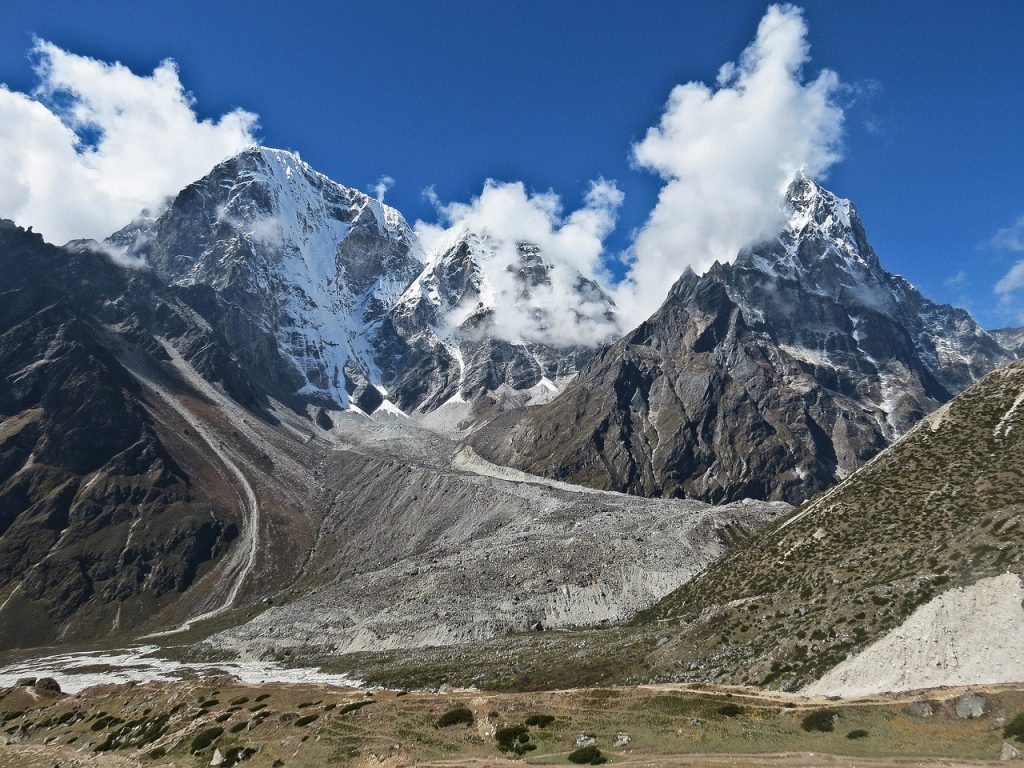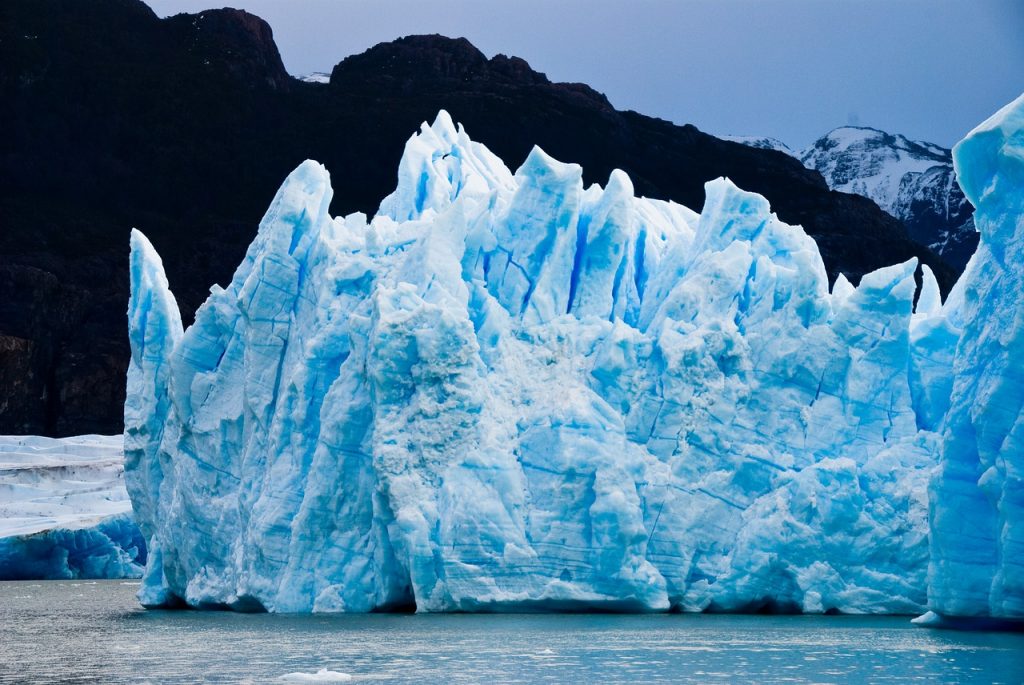There are so many beautiful places to explore on this planet, and there are few better ways to do it than on foot. Trekking has become a favoured pastime and thankfully there are some incredible trails out there that are safe and accessible to most people. We looked at seven world-famous treks and ranked them in order of difficulty, from most advanced to least. Just remember that even though some of these are definitely for the advanced trekker, they are still attainable with the right training and preparation.
Discover here the training for Machu Picchu

Routes For More Advanced Trekkers
1. Everest Base Camp, Nepal
Base Camp is a great way to experience Mount Everest without actually needing to be a seasoned mountaineer. It’s more attainable than people realise and is a noteworthy bucket list item that some have strived towards their whole lives. Once on the journey, it’s a cultural and natural explosion for the senses that will be remembered forever.
- Best time to go: between August and November
- How long it takes: 13 days
- Distance covered: 62km and 5,380m elevation
- General fitness required: intermediate to advanced
- Special equipment or tips: you will need to acclimatise — ensure your tour provider or trail includes time for this
2. Kilimanjaro, Tanzania
The great trek up Kilimanjaro is both beautiful and challenging and there are multiple routes that take you through a number of different natural terrains. From glaciers to forests to open savannah, you will get to experience all of this and more during the climb. The route you choose will determine the level of difficulty, so ensure you go with one that matches your ability.
- Best time to go: between September and March
- How long it takes: Up to 8 days
- Distance covered: 34km, with 5,895m elevation
- General fitness required: intermediate to advanced
- Special equipment or tips: most tour operators will supply you with a tent, so make sure you will have a decent one that is suitable for the expected weather conditions. If you’re doing any other route except Marangu, it’s a good idea to also take a thermal sleeping mat or sleeping bag liner for additional warmth
3. Camino de Santiago, France And Spain
The Camino de Santiago follows the route of one of the most important Christian pilgrimages that repeatedly took place during medieval times. It’s now a social hiker’s paradise that people often complete for personal development or spiritual reasons. It starts in France in the Pyrenees and finishes in Santiago de Compostela in Spain.

- Best time to go: summer months, although it can be hectic at this time
- How long it takes: roughly four to six weeks
- Distance covered: 750km
- General fitness required: intermediate to advanced. Mental fitness is needed to overcome the length, and you’ll need great endurance as well.
- Special equipment or tips: stable, quality hiking boots and loads of socks. Bring cash for restaurants and accommodations along the way.
Treks For Intermediate Hikers
4. The Inca Trail, Peru
The original trail as walked by the Incas is one of the most popular routes to trek today, which is not surprising when you consider the captivating views and experiences offered at every step of the way. The trail begins in the Sacred Valley and ends in Machu Picchu, giving hikers a taste of the incredible countryside as well as the enigmatic, spiritual side of this ancient Incan empire.
- Best time to go: between May and September (the trail closes down in February for maintenance)
- How long it takes: 4 days
- Distance covered: 43km, 4,215m elevation
- General fitness required: intermediate
- Special equipment or tips: it is essential that trekkers acclimatise for a day or two in Cusco before embarking
While the Inca Trail was stunningly beautiful, the hike itself is physically demanding. We were exhausted since the first day between the climb and the high elevation, which meant we were out of breath more. You also can’t predict the weather and may have beautiful clear skies or heavy rain. Our hike started with sunny weather, but we encountered drizzling rain for two days straight, which makes hiking more difficult and a group generally more grumpy. That said, the rain made for some beautiful, atmospheric photos of our time on the trail.
The moment we reached the Sun Gate on the fourth day of our hike was spectacular. We were exhausted, but I will never forget our first glimpse of Machu Picchu from above. It felt like all of our hard work had paid off, and we were getting to experience one of the many wonders of the world by ourselves before everyone else was even awake for the day. – Jess & Nate, Round the World Couple
My biggest challenge was learning to pace myself. It’s easy to start out strong because you’ve made it to Peru and you’re excited to be walking the Inca Trail, but when you start to hit those steep inclines, and the sun is beating down on your back, and you’re feeling the altitude, and you realize you may have overpacked a bit, you need to remind yourself to just take it one step at a time and that slow and steady wins the race…or in this case, slow and steady gets you to Machu Picchu!
For me, the highlight of the trip was reaching Wiñay Wayna, an archaeological Inca site that is made up of terraced ruins that overlook the Urubamba River. I didn’t even know this place existed before walking the Inca Trail, so seeing it for the first time without any preconceived notions was an incredible moment and a much-welcomed sight after a long morning of hiking. To me, Wiñay Wayna was just as impressive as Machu Picchu (if not more!), but because the only way to reach these ruins is by walking the Inca Trail, there were no crowds whatsoever; there were only 5 of us there – our group of 4 hikers and our guide. – Audrey, That Backpacker
5. Mont Blanc, Switzerland, Italy and France
The beauty of this hike will take your breath away, but it doesn’t come without a challenge. Passing through three countries is quite a feat but you will be rewarded with gifts of Alpine beauty around every corner. Traverse meadows, rocky outcrops and picturesque mountain villages, all while walking alongside some of the grandest and most impressive peaks of the Alps.
- Best time to go: between June and September
- How long it takes: 8 days
- Distance covered: 125km, 4,810 m elevation
- General fitness required: intermediate to advanced, but mainly because of the distance covered
- Special equipment or tips: a really sturdy pair of hiking boots and light, comfortable clothing
6. Torres del Paine Circuit, Patagonia

Patagonia is one of the most beautiful, unspoiled corners of the world, seemingly untouched by man. The Torres del Paine Circuit takes you on a trail (with multiple starting points) at the tip of South America past volcanic vistas, crisp glaciers and through rolling plains that seem to go on forever. It’s a magnificent experience for the scenery alone, but the trail also provides some challenging bits that are definitely character building.
- Best time to go: between December and March
- How long it takes: 10 days
- Distance covered: 133km
- General fitness required: intermediate
- Special equipment or tips: exceptional hiking shoes and a great quality tent
My adventure at Torres del Paine was completely unplanned. I was supposed to go with a boat to Chile but since the boat was full for many more days to come I decided to join some friends for the W track. They had been asking me for weeks and I kept stalling due to the boat trip. When I finally got a clear picture that the boat trip was never going to happen I had to quickly prepare myself for the W track at Torres del Paine. The feeling of being so unprepared was a challenge itself, but getting into something so wonderful without having a clue was totally worth it.
The final hike up to see the sunset on the last day would seem like the most beautiful moment of the trip. However for me the Grey glacier was so impressive it took my breath away. I just loved seeing that glacier ice in contrast with the sunny day and the blowing flowers by the hiking path. Enjoying such a view with travel friends is worth gold. – Renate, That Wanderlust
One Of The Best Treks For Beginners
7. The Lost City, Colombia
The Lost City of Teyuna takes you back to explore a city that came into existence even earlier than the Incan civilisation of Machu Picchu. The ruins themselves are amazing to take in, but the journey getting there is even more so. The trail takes you through jungles and over crystal clear rivulets, while you sleep some nights in hammocks that have been placed there for hikers just like you.
- Best time to go: between December and March
- How long it takes: 5 days
- Distance covered: 44km
- General fitness required: beginner to intermediate
- Special equipment or tips: take a swimming costume with so you can cool off in the beautiful rivers on the way
Which matches your level of ability while appealing to your travel interests at the same time?


